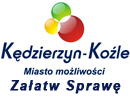Koźle legends
A long, long time ago…
As legend has it, in the pool of the Oder River surrounded by swamp, close to the town, a powerful, strong castle once stood. It was ruled by three Kozłowie brothers. They were thus called not by any chance, but because their appearance, and especially the shape of their heads and narrow, pointed beards, became similar to goats. Although they were born to the station of knights, they did not pride themselves of any brave deeds. Their occupation was low: they were in robbery. The castle was near the merchant route leading from far-awat Italy to the country of the Pomeranians at the Baltic Sea. Oil and precious materials were transported there and a brown stone called amber was brought back. That is why this area constituted an ideal place for robber knights who could stage ambushes on the merchants. The Kozłowie were harassing not only for those carrying the goods but also to the neighbouring people. When no merchants were nearby and over time the route grew mostly empty, therobber knights attacked the neighbouring villages and towns. They plundered everything they could, they murdered everybody, not only men trying to defend themselves but also women and children. Those vile expeditions were carried out mainly at night. Then the glow of burning thatches were visible far away and the cries of the injured reached even to distant localities.
No wonder that the brothers were not liked by the people living near and far. The news of the despicable acts of the three brothers also reached the ruler of those lands – Mieszko I, called Tanglefoot, the Duke of Opole and Raciborz. Repeatedly he sent his troops to catch the robber knights. This was no easy task because they could escape every pursuit and by secret passages reached the castle. There was also a high reward of 100 silver denar coins for everyone who assisted in capturing the robbers. All were afraid of revenge.
And so the days, months, and years passed by and the robbers still plundered with impunity. They collected more and more treasure in their castle. In those times, a brave and clever town butcher lived in the town close to the castle, called Jacob in honour of the patron of the butchers’ guild, and by friends Kuba. Kuba, who sometimes visited the castle to deliver food, also grew familiar with the secret of the various corners and passages. Knowing how having the three brothers as neighbours troubled the local people, he went to Duke Mieszko, bowed and promised help in capturing the robber knights.
On a dark autumn night, when the town was deeply asleep, the knights of the Duke, led by Kuba, moved on the castle. An impenetrable darkness prevailed all around and the silence was disturbed only by distant howl of wolves.
Light glowed only in the small windows of the castle tower. Right there, the robber knights were counting the rich spoils from their latest plundering raid. On the previous day, they had robbed the merchants who were carrying money for the purchase of amber.
Mieszko’s warriors, led by Jacob who by paths known only to him could get into the castle through underground passages, reached the dungeons. From there, quietly passing by the guards, they climbed the tower. The Kozłowie brothers, surprised by the sight of the Duke’s warriors, did not have time to call for help – they grabbed swords themselves. After a short but furious fight, the astonished robbers were captured.
There was no mercy for them. There where they were captured at the division of their booty, the punishment was decided. They were thrown from the windows of the tower straight into the dark waters of the River Oder. They all died.
Since then, over many centuries, the elders of the butchers’ guild on Jacob’s namesday, organized a march in the streets of the town with an effigy of a goat. It was thrown then from the tower at Raciborz Gate. Together with the fall of the goat, cheerful shouts were heard and afterwards the gathered people went to the nearby inns to go on celebrating. The castle of Kozłowie brothers remained empty and fell into ruin but the town located close to it developed and over time it adopted the name Koźle. In its emblem, three goat headsappear. The custom of a march with a goat on the First of June, on Saint Jacob’s Day has survived as a memory of those events.







